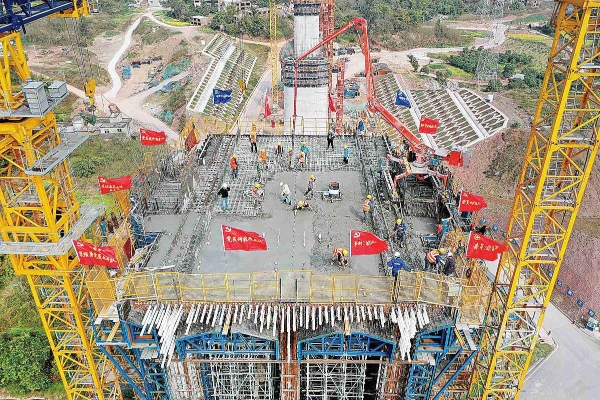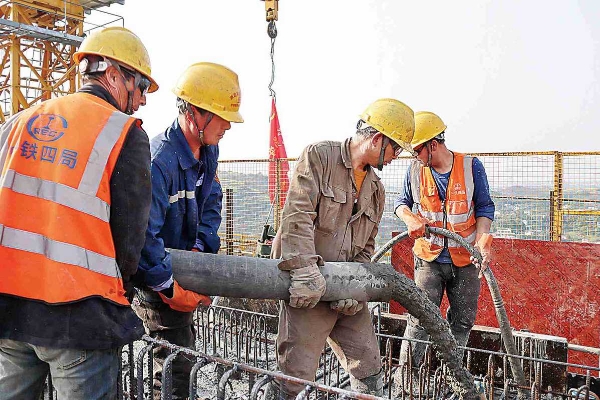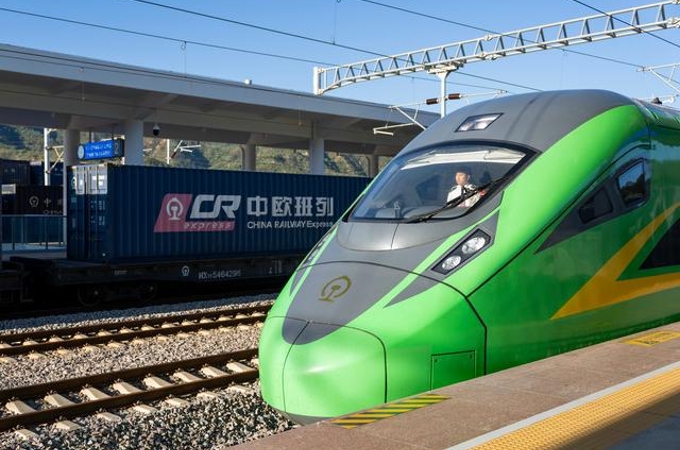CREC4 makes strides in super bridge project
Source: Xinhua | 2022-03-17 | Editor:Lexi

Builders from China Railway No 4 Engineering Group Co Ltd work on a main pier of Tuojiang super bridge in Sichuan province on Sunday, which is part of the Beijing-Kunming High-Speed Railway Corridor. [Photo provided to China Daily]
Builders of the 2,440-kilometer Beijing-Kunming High-Speed Railway Corridor, one of the nation's "eight verticals and eight horizontals" in the HSR network, made a new breakthrough after they finished cement pouring on top of a main pier of the Tuojiang super bridge in Sichuan province.
The Tuojiang Super Bridge will stand on two main piers, No 40 and No 41, with a total length of 2,613.3 meters. Cement pouring was completed on Sunday for the two blocks on the No 41 pier on the south bank of Tuojiang River, an upper tributary of the Yangtze River, the country's longest river.
After more than 10 hours of intense work, builders from China Railway No 4 Engineering Group Co Ltd (CREC4) celebrated their successful work on the two blocks, ushering in the official construction of the overhanging beam of the super bridge.
CREC4 staffer Zhang Furong said the main span will be composed of three sections of 124 meters north of the No 40 pier on the north bank of the river, 240 meters between the two main piers and another 124 meters south of the No 41 pier.
The Tuojiang super bridge is the most difficult bridge to construct for the Chongqing-Kunming section. It is located in the suburbs of Luzhou and its double-column V-shaped bridge tower on its two main piers is the first of its kind to be built in China, Zhang said.
CREC4 is building the super bridge, whose main span in three sections is also the longest continuous beam on the Chongqing-Kunming section, he said, adding the bridge, which began construction early last year, will end construction by January next year.
Yin Ze, chief engineer of the project from CREC4, said the two blocks on pier 41 standing some 75 meters up from the ground, are difficult to handle. A huge amount of cement was needed, with high prestressing demand in addition to difficulties in tying off the steel bars.
The concrete volume covering some 2,000 square meters and running up to 13 meters in height is immense, he said. It required extremely high-stress performance and installation accuracy in the overall load-bearing brackets.

CREC4 builders pour cement on the No 41 pier of Tuojiang super bridge in Sichuan province on Sunday. [Photo provided to China Daily]
The steel bars which weigh more than 150 metric tons on the two blocks are also complex, as there were 23,000 bars in 69 kinds of forms, posing high risks in construction in such a limited working space, Yin said.
The joint research team set up a task force to make technological breakthroughs, laying a solid technical foundation for the successful pouring, he said.
Zhang said the Chongqing-Kunming HSR, which runs 699 kilometers with a designed speed of 350 kilometers per hour for the trains, is an important component of the Xi'an-Kunming section of the Beijing-Kunming Corridor.
Upon completion, a new HSR channel will be added between Chongqing and Kunming, greatly improving the mobility of residents along the line and ushering in a "new layout" for the economic life of related regions.
Zhang noted that the Beijing-Kunming HSR Corridor, as a north-south artery being built section-by-section, is expected to be completed and put into operation by 2026.
Qian Zhongyue, 33 and a father of one, is the leader of the construction team. He said he is quite happy with his job at CREC4 in building the Tuojiang super bridge, as he is making a contribution to this national HSR artery.
"My biggest feeling at the construction site is I'm very busy, because as a team leader, I have to lead nearly 70 workers at the worksite every day. Furthermore, our project has two shifts-a day shift and a night shift," he said. "But for a big project like this, it is worthwhile."







